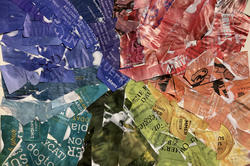Continuing Education partners with Rhode Island Department of Education to offer free online art and design classes to underserved youth.
New Scholarships Boost Accessibility

The mission of RISD’s Continuing Education (CE) division is “to provide an immersive and innovative art and design education for everyone, at all stages of life and all levels of experience.” That commitment to accessibility has been bolstered in recent months by a number of new relationships with outside organizations providing scholarships for historically underrepresented students.
“Diversifying CE’s student population is part of a larger institutional effort to increase overall diversity [at RISD].”
“Diversifying CE’s student population is part of a larger institutional effort to increase overall diversity in support of RISD’s Social Equity and Inclusion Action Plan,” says CE Executive DirectorSarah Caggiano.

New scholarships supporting students of color are now available from Crafting the Future, a nonprofit dedicated to diversifying the fields of art, craft and design by connecting BIPOC artists with opportunities that will help them thrive; Creatives Want Change, an organization working to cultivate Black creative talent beginning at the high school level and continuing into early professional development; and the Tomaquag Museum in Exeter, RI, whose mission is to educate the public about Indigenous history, culture and arts.
Now that RISD’s CE classes are all available online, youth from across the country are able to take advantage of these scholarships and join the RISD community. “These organizations are focused on helping to level the playing field by providing BIPOC students with pre-collegiate experiences that will prepare them to pursue a career or an undergraduate education in art and design,” Caggiano says.

It was just such a formative pre-college experience—at RISD—that helped furniture maker and Crafting the Future Deputy Director Annie Evelyn 99 FD/MFA 07 find her path. “The work that I made in those six weeks is what got me into RISD and all the other art schools I applied to,” she says. “I’m so thrilled to start this partnership and expand that amazing opportunity to more people.”
“RISD’s Pre-College Program created a sense of possibility and exposed me to new experiences.”
Creatives Want Change cofounder Matthew Kane had a similar epiphany as a teenager at RISD and went on to study menswear design and eventually become design manager at Club Monaco in NYC. “I had a strong interest in fashion but wasn’t raised in a particularly creative household,” he says. “RISD’s Pre-College Program created a sense of possibility and exposed me to new experiences. It’s one of the reasons I’m committed to partnering with the best design schools across the country to provide access to pre-college programming for Black students of promise,” he says.

Closer to home, CE continues to partner with the Rhode Island Department of Education (RIDE) to provide free classes to Rhode Island teens attending public schools. “The RIDE partnership is key to these efforts,” says Director of CE Marketing and Communications John Murphy, “with 62 students participating this summer alone.”
“The classes intentionally focus on social justice and difficult conversations that help young people work through these issues.”
Most of the scholarship students are joining the Advanced Program for High School Students created last year, whose curriculum was built to address contemporary issues and promote activism. “The classes intentionally focus on social justice and difficult conversations that help young people work through these issues, which are pressing and real,” says Director of Program Planning and Development Mariah Doren.

One example is a class currently in session called Art & Social Justice. Taught by Rene Payne 83 GD, it encourages students to grapple with complex issues like xenophobia and social inequity and to investigate how artists can become powerful agents of change. Working within a framework employed by noted artist/activist Emory Douglas, students learn to combine type and images to create meaningful graphic messaging for use in print and on social media platforms.
“These kinds of experiences really help young people discover who they want to be in the world,” says Doren. “And that’s a shift in our pedagogy we’re really proud of.”
—Simone Solondz
August 11, 2021


